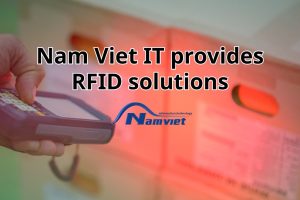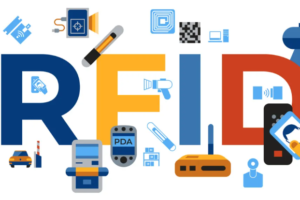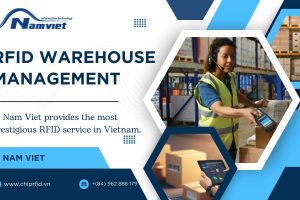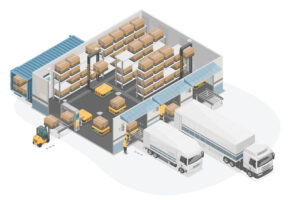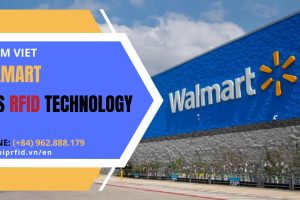If you are working in the field of supply chain management, logistics or retail, you must have heard of RAIN RFID. However, in reality, what is RAIN RFID, how is this technology applied,… are still the questions of most people today. The following article by IT Nam Viet will help you answer in the most detailed, clear and complete way.
What is RAIN RFID?
RAIN RFID is an acronym for RAdio frequency Identification – a technology standard that uses ultra-high frequency (UHF) radio waves to identify and track objects remotely. RAIN RFID is not just a chip or a readable design, it is an “ecosystem” that connects billions of objects in the digital world, creating the foundation for the Internet of Things (IoT) in reality.
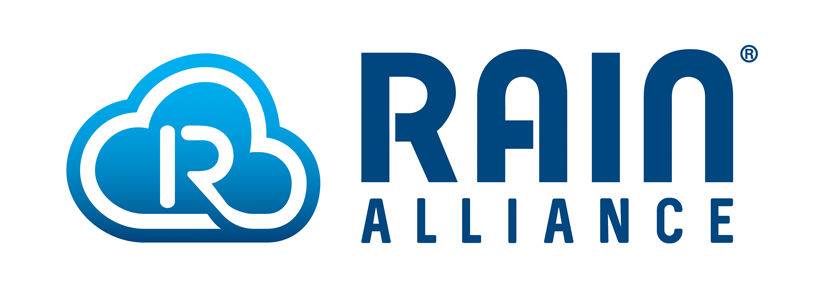
In essence, RAIN RFID is a globally standardized version of UHF RFID Gen 2 technology, complying with ISO/IEC 18000-63 standards. Accordingly, the special feature of RFID RAIN technology is the ability to operate WITHOUT batteries (passive), can read hundreds of tags at the same time with a range of up to 15 meters, and does not require direct vision. This is the difference between the RAIN RFID system and traditional barcode technology.
About RAIN Alliance
Prior to 2014, the UHF RFID market was fragmented. Despite the advent of the EPC Gen 2 standard, the industry lacked a unified nomenclature and lacked a strong enough organization to coordinate and promote uniform adoption globally. To address this limitation, in 2014, four pioneering companies, Impinj, Intel, Google, and Smartrac (now part of Avery Dennison), co-founded the RAIN Alliance.
This non-profit organization undertakes important tasks such as:
- RAIN brand management.
- Promoting the popularity of RAIN RFID technology.
- Certifying compatibility, creating an open and unified ecosystem.
With the creation of this organization, businesses can confidently invest in a global standard that is highly scalable, stable, and not “locked” into any single vendor.
According to RSR, 95% of retailers believe that RAIN RFID will become a key component of their digital transformation.
What Components Does the RAIN RFID System Consist of?
Accordingly, a standard RAIN RFID system includes the following basic components:
- RFID tag: RFID label is attached to each product object, no battery required, can withstand harsh environments.
- RFID card reader: Can be a fixed RFID reader or a handheld RFID scanner, emits radio signals, activates the tag and receives return information.
- Antenna: Expands coverage, ensures mass reading speed.
- Software: Data management, Cloud connection, ERP/WMS integration
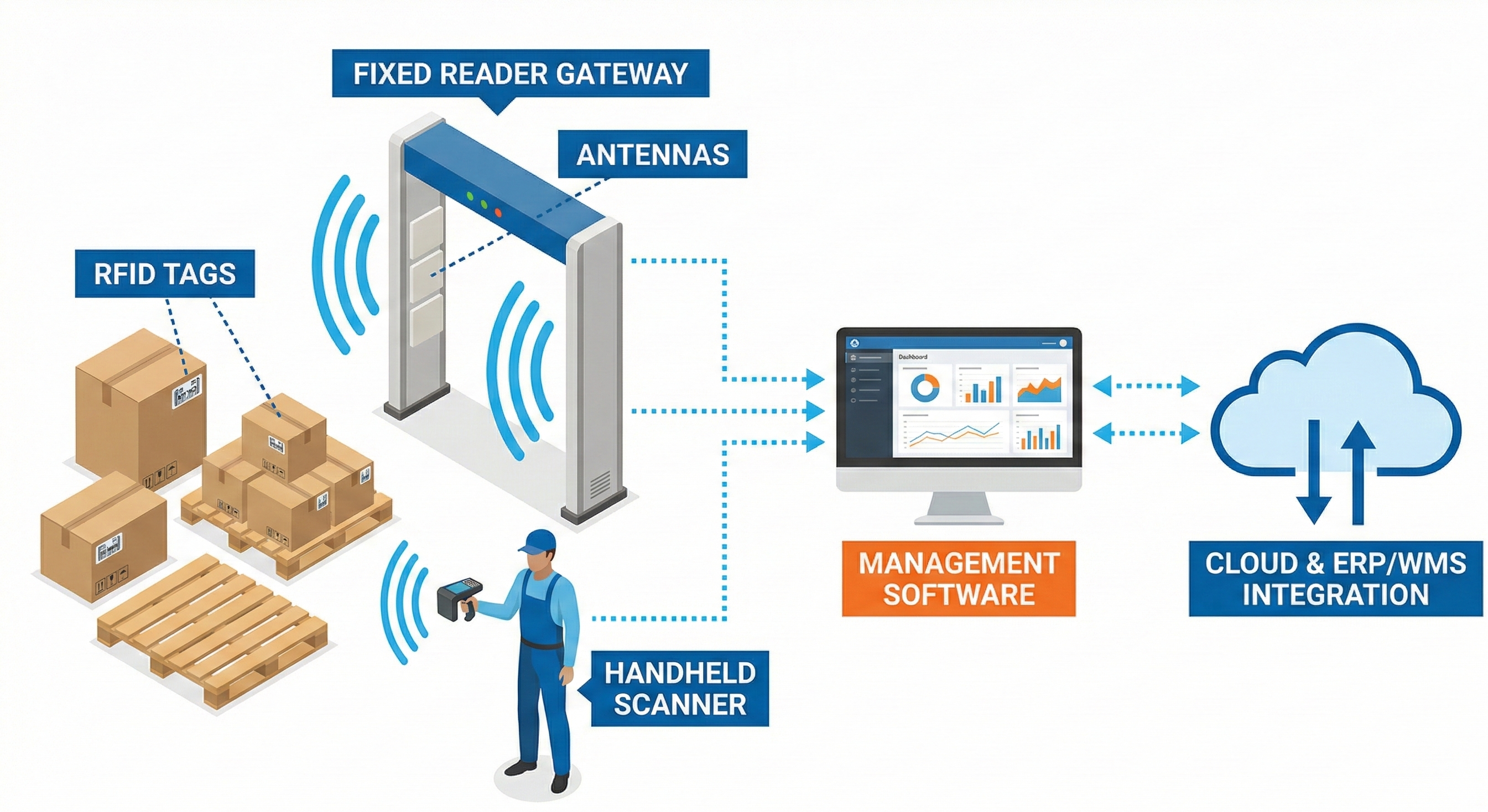
How RAIN RFID Works
RAIN RFID works on the principle of radio waves: RFID readers emit radio waves that activate passive RFID tags, which then respond with data without batteries or direct line of sight. This process takes place in milliseconds, allowing for mass reading of RAIN RFID-tagged objects.
RAIN RFID can identify and locate up to 1,000 items per second without direct sight.
Evaluation of Outstanding Advantages of RAIN RFID System
For businesses, investing in a RAIN RFID system is not a cost, it is a long-term profitable investment thanks to its outstanding performance. Below are the outstanding advantages of RAIN RFID that businesses should learn more about:
Inventory management with up to 99% accuracy: Completely overcome the error situation, the situation where the system reports that there is stock but there is not on the shelf.
Increase inventory speed: Manual inventory work that took 8 hours now only takes 30 minutes, 100% automation of the import/export process when the forklift passes through the RFID card reader gate.
Inventory with RAIN RFID handheld readers is 25 times faster than barcode readers.
Unlike barcodes, RAIN RFID tags can be read without direct sight—even through a box or container.
Process automation: The RAIN RFID system automatically records incoming and outgoing goods without requiring employees to stop to scan by hand, which helps businesses significantly optimize operating costs. Of course, the accuracy is higher than traditional manual inventory work.
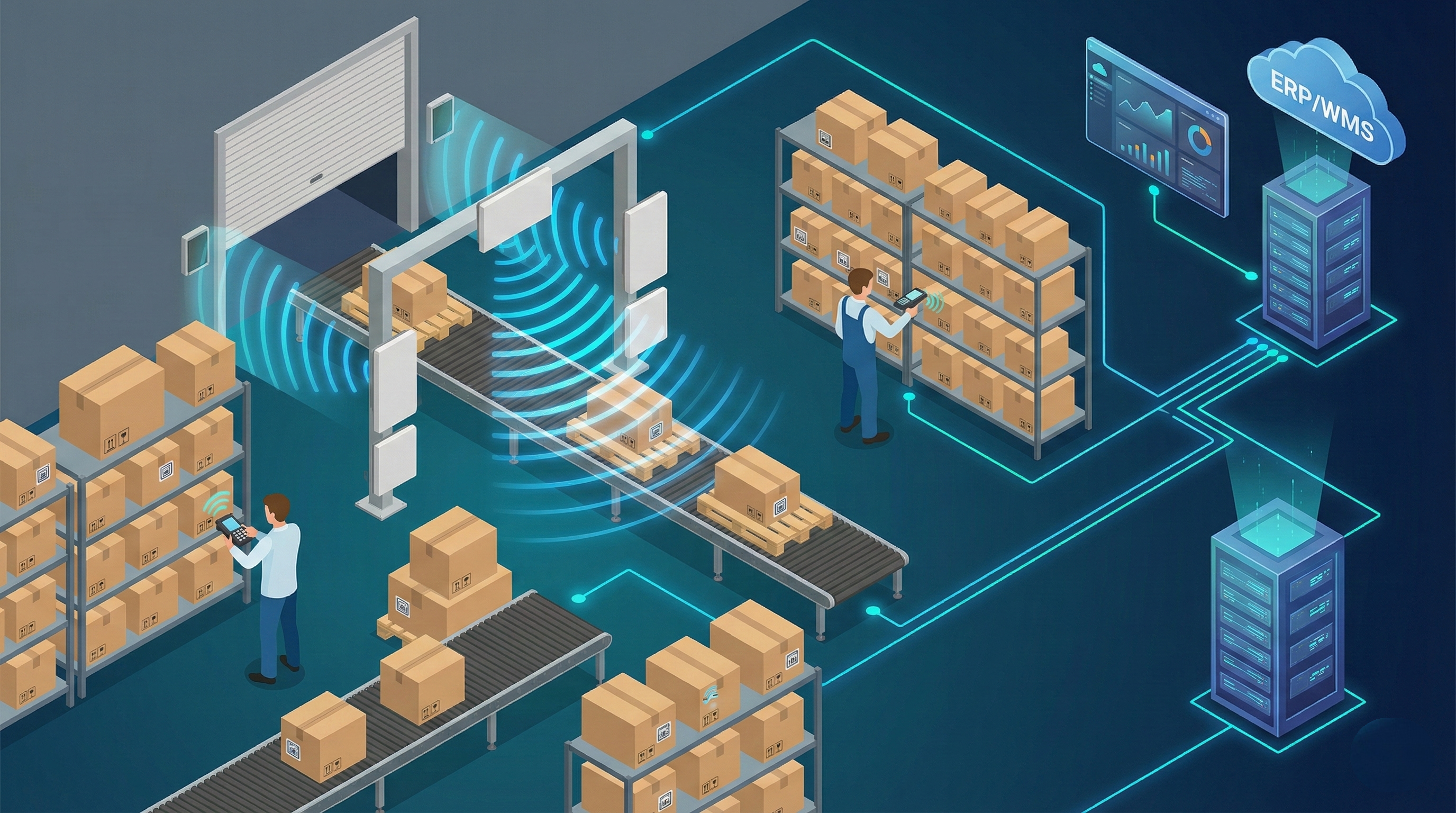
Supply chain visibility: With the RAIN RFID system, businesses can easily track goods accurately in real time, from the time they leave the factory, through the distribution center to the time they reach retail stores.
Enhance customer experience: With automatic payment applications, the ability to accurately display each item on the shelf, … RAIN RFID helps to significantly improve the customer experience, which is a factor that helps increase competitiveness compared to competitors in the same industry.
Anti-counterfeit RFID: Each RFID tag is assigned a unique ID code that cannot be copied, helping to ensure product authenticity.
Optimize assets and prevent loss: Track reusable assets such as pallets, containers, carts, … reduce loss and optimize asset usage.
Comparing RAIN RFID Technology with NFC and Barcodes
Nowadays, RAIN RFID technology has been applied by most businesses and brought many great results in company development. Below is a comparison table of RAIN RFID technology with NFC and barcode, helping customers easily make the right decision:
| Comparison Criteria | RAIN RFID Technology | NFC Technology | Barcode Technology |
| Reading Method | Reads through obstacles (cardboard, wood, plastic), reads hundreds of tags simultaneously | No line of sight needed, but requires close proximity (distance < 10cm) | Requires direct line of sight, manual scanning of each tag individually |
| Reading Distance | Long range, can be up to 15m | Very short, almost touch contact like elevator access cards, payments, etc. | From a few cm to a few meters, depending on the scanner |
| Durability | Durable, performs well in industrial environments | Durable, withstands harsh environments | Easily torn, faded barcodes, unreadable |
| Data Writing | Can be rewritten and reused | Can be rewritten | Cannot be changed after printing |
| Applications | Warehouse management RFID, logistics, asset inventory, etc. | Payments, timekeeping RFID, electronic ticketing, etc. | Retail, supermarkets, etc. |
See more: NFC and RFID Technology: What Are the Differences, Which Solution Should You Choose?
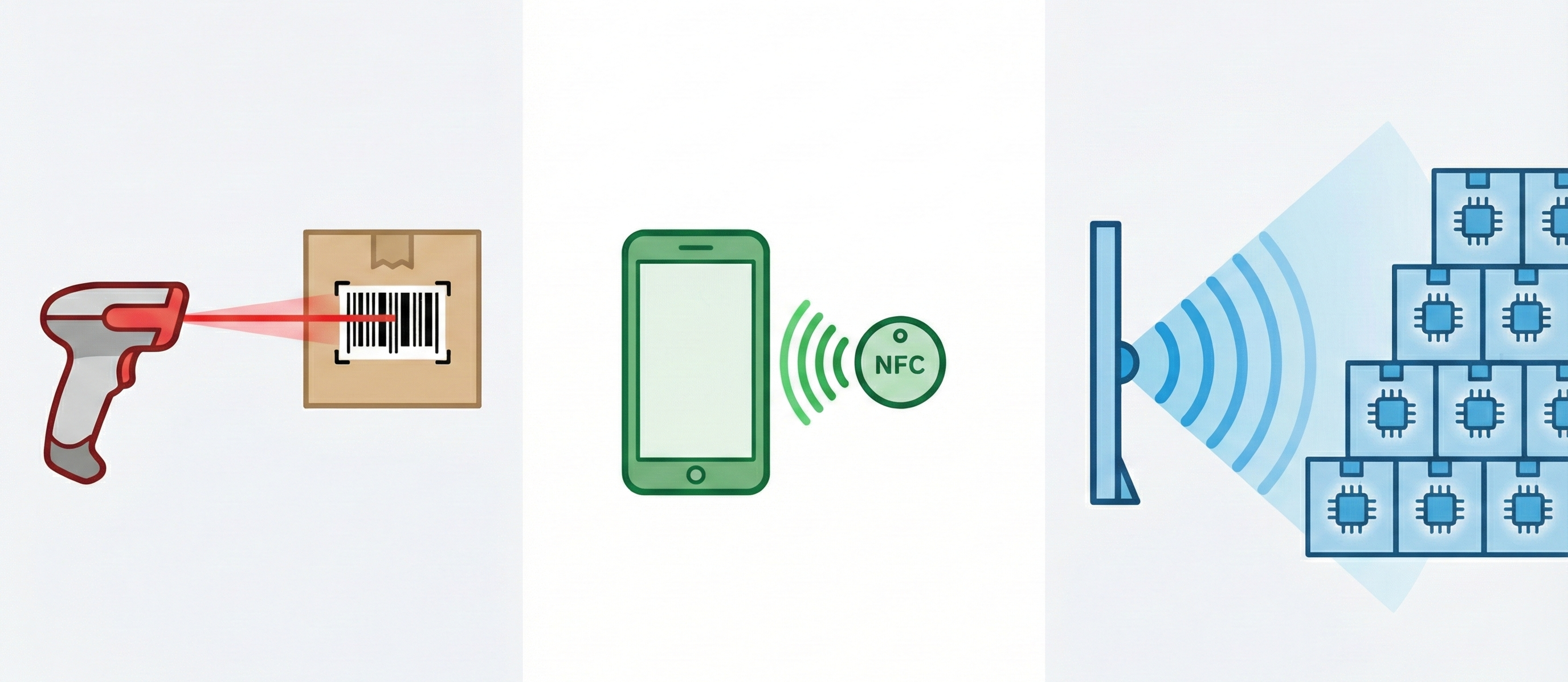
Applications of RAIN RFID
Nowadays, RAIN RFID technology has been developing at a rapid pace, meeting the strict requirements of domestic and foreign enterprises. At IT Nam Viet, we constantly update the latest technology trends to bring optimal solutions to customers.
Common applications of RAIN RFID include:
RAIN RFID in Retail
Big names like Walmart, Decathlon,… have asked suppliers to label 100% of their products with RAIN RFID. This not only helps with quick inventory but also supports automatic payment, meaning customers only need to drop their shopping cart into the machine and the system will automatically calculate the payment. Compared to traditional barcode scanning for each item, using RAIN RFID in retail helps enhance customer experience, improve and increase productivity effectively.

RAIN RFID in Logistics
Previously, the manual warehouse import and export process by scanning barcodes for each item was labor-intensive and prone to errors. Now, the RFID solution has helped businesses completely solve this limitation. For example, a forklift carrying a pallet of 50 boxes passes through a gate with an RFID reader, the system automatically records exactly 50 boxes in a few seconds without having to stop. This solution helps to automate the entire manual inventory process, reducing 90% of human resources, ensuring almost absolute accuracy.
Application of RAIN RFID technology in medicine
RAIN RFID technology is revolutionizing the healthcare industry thanks to its ability to automate management processes. Unlike barcodes, RAIN RFID allows hospitals and medical facilities to identify and track a wide range of equipment, machinery, pharmaceuticals and test samples remotely. This solution helps optimize inventory, prevent lost assets, and strictly manage the expiration dates of medicines, functional foods, etc.
You can see details in the article: Application of RFID Chip in Healthcare Management, Enhancing Healthcare
Some other applications of RAIN RFID technology
In addition, RAIN RFID technology is also applied in other fields such as:
- RAIN RFID in Airport Baggage Management
- RAIN RFID in Asset Management
- RAIN RFID Application in Automatic Payment
- RAIN RFID Application in Preventing Theft and Loss of Goods
- Manage each shipment accurately with RAIN RFID solution
Professional RFID Technology Consulting in Vietnam – IT Nam Viet
With the increasingly strong speed of digital transformation, the need to apply RFID technology to goods management, logistics, production, businesses, etc. is increasing rapidly.
In Vietnam, IT Nam Viet is proud to be one of the prestigious and professional RFID suppliers, committed to providing customers with comprehensive solutions from survey, system design, equipment selection to software deployment, and actual operation.
IT Nam Viet owns a team of skilled technicians with experience in multi-industry RFID deployment, ensuring to bring businesses solutions suitable for their usage needs as well as investment financial conditions. We not only provide technology consulting, we also support to bring smart, sustainable and suitable operating solutions for each operating environment.
In addition to available RFID label warehouses, IT Nam Viet also designs and manufactures RFID cards with chip types, sizes, etc. according to customers’ specific requirements. We are committed to competitive pricing, RFID prices depend on each business model, environment, related service fees,…
To receive advice on RAIN RFID solutions, please contact IT Nam Viet via Hotline (+84) 962 888 179!
FAQs – Frequently Asked Questions
Below is information to answer customer questions about RAIN RFID technology:
Is RAIN RFID secure?
YES. RAIN RFID uses low-power radio waves, complying with global safety standards. Data on RAIN RFID tags can be encrypted to prevent unauthorized copying, ensuring safety for applications such as anti-counterfeiting. Regarding this issue, readers can visit our following article for more details: Are RFID Tags Safe? Answers From Experts
How does RAIN RFID tag identify items?
The RAIN RFID chip is pre-programmed with a tag identifier, a unique serial number assigned by the chip manufacturer, and includes a memory bank to store the product’s unique tracking identifier, also known as the electronic product code – EPC. The chip does not require a battery and can be read from up to 10 meters away without direct sight.
Why don’t RAIN RFID tags need batteries?
When the RAIN RFID reader emits radio waves to access and read the tag chip, the tag’s antenna collects some of that radio energy and transmits it to power the chip.
RAIN RFID is no longer a technology of the future, it is a technology of the present. The RAIN RFID system allows businesses and consumers to identify, locate, authenticate and interact with any RAIN RFID-tagged item, providing rich data and detailed information in real time.
Currently, RAIN RFID is widely applied in many fields, typically supply chain, factory automation, retail, warehouse management, … If you need advice on RFID technology, do not hesitate, call us immediately via Hotline (+84) 962 888 179 for support!
My name is Le Nam Viet, currently FOUNDER & CEO of Nam Viet IT Company, I graduated from Ho Chi Minh Polytechnic University. I have more than 3 years of experience providing RFID chip technology solutions, RFID scanners, barcode labels and barcode readers. It’s a pleasure to share my knowledge with readers.



 Tiếng Việt
Tiếng Việt
